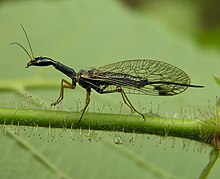Snakeflies
| Snakefly Temporal range: Lower Jurassic–Recent |
|
|---|---|
 |
|
| Female Dichrostigma flavipes | |
| Scientific classification | |
| Kingdom: | Animalia |
| Phylum: | Arthropoda |
| Class: | Insecta |
| (unranked): | Endopterygota |
| Order: |
Raphidioptera Handlirsch, 1908 |
| Suborders | |
|
see text |
|
| Synonyms | |
|
|
see text
Snakeflies are a group of insects comprising the order Raphidioptera, which is divided into two families: Raphidiidae and Inocelliida consisting of roughly 260 species. Together with the Megaloptera they were formerly placed within the Neuroptera, but now these two are generally regarded as separate orders. Members of this order have been considered living fossils, as the phenotype of a species from the early Jurassic period (140 million years ago) closely resembles modern-day species.
The order's name, Raphidioptera, is derived from the Greek "raphio", which means needle, and "ptera", which means wing.
Adult snakeflies are characterized by having an elongate prothorax but no modification of the forelegs (as in Mantispidae). They have strong and relatively unspecialised mouthparts, and large compound eyes. Some species also have ocelli. The females typically have a long ovipositor, which they use to deposit their eggs into crevices in bark or rotting wood. The two pair of dragonfly-like wings are similar in size, with a primitive venation pattern, and a thickened costal margin (or "pterostigma").
The larvae have large heads with projecting mandibles. The head and the first segment of the thorax are sclerotised, but the rest of the body is soft and fleshy. They have three pairs of true legs, but no prolegs. However, they do possess an adhesive organ on the abdomen, which they can use to fasten themselves to vertical surfaces.
There is no set number of instars the larvae will go through, some species can have as many as 10-11. The larval stage usually takes around 2–3 years, but in some species can take as long as 6 years. The final larval instar creates a cell in which the insect pupates. The pupa is fully capable of movement, and often leaves its cell for another location before the adult emerges. All snakeflies require a period of cool temperatures (probably around 0 °C) to induce pupation. Depending on when the snakefly pupates determines the length of pupation, Most species pupate in the spring and can take a few days to 3 weeks. Some species seen in more tropical climates will pupate in the early summer and takes around 3 weeks before reaching adulthood. If the larvae begins pupation in the late summer or early fall it can take up to 10 months for pupation to complete.
...
Wikipedia
